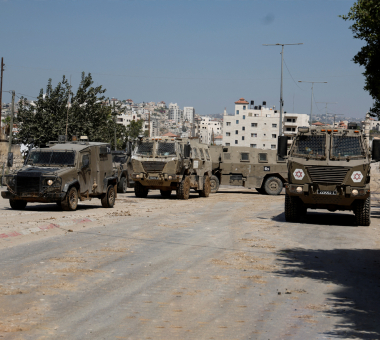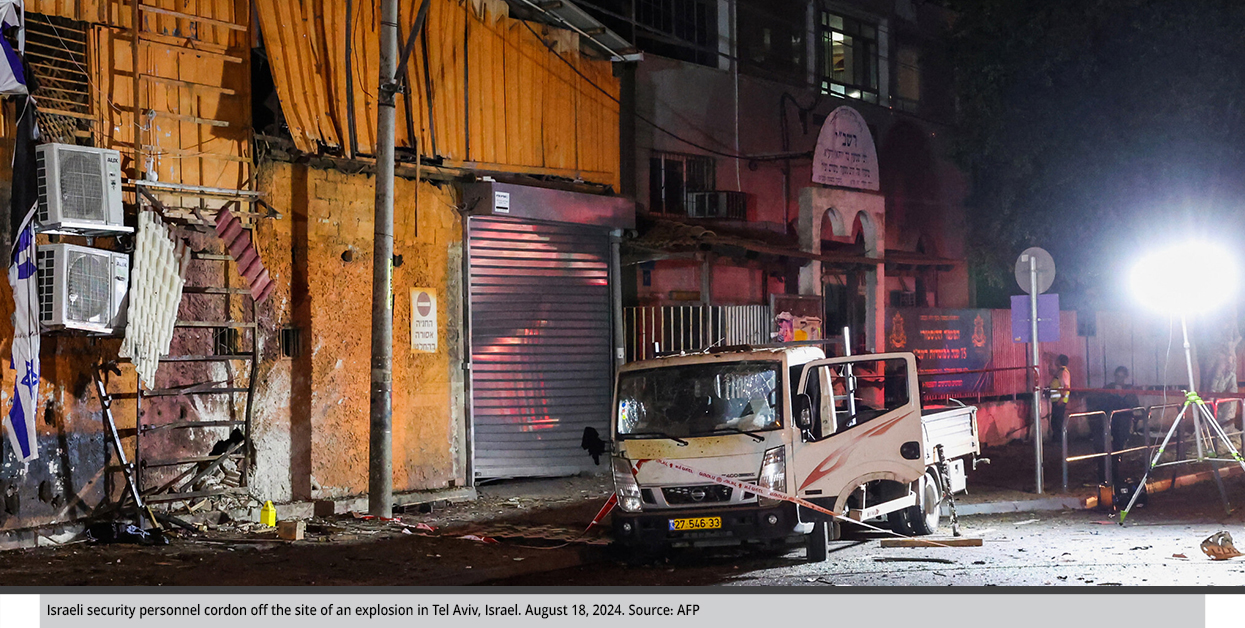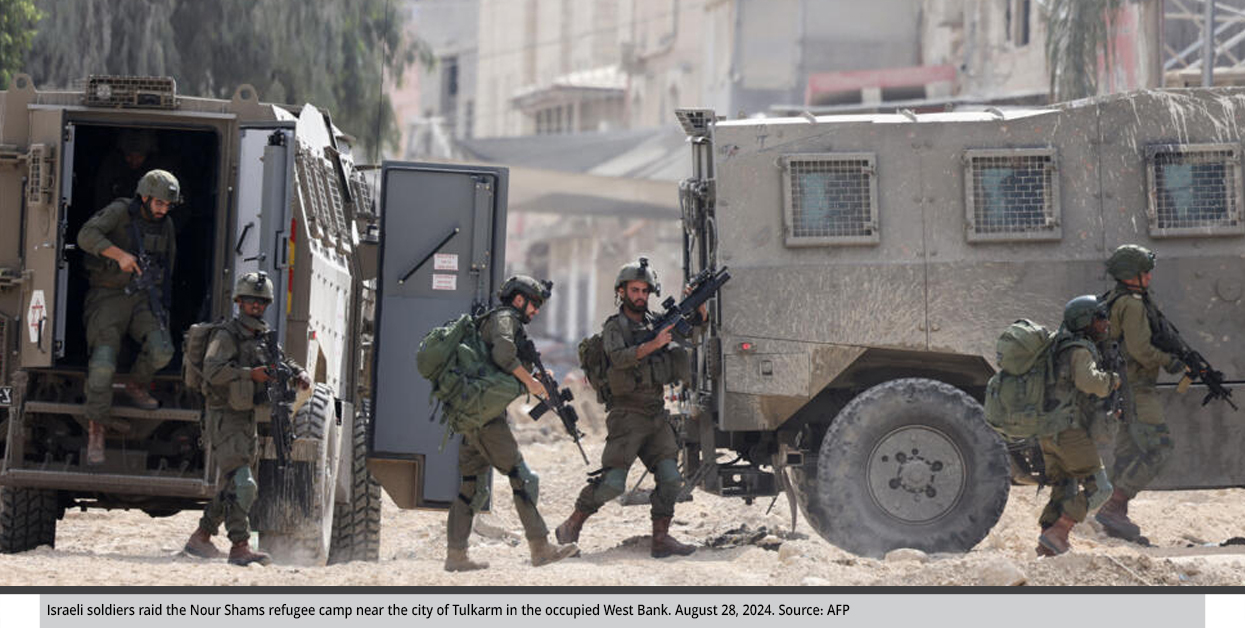How Can Israel’s “Summer Camps” Operation in the Northern West Bank Be Interpreted?
The Israeli security and political objectives behind the military operation in the northern West Bank and Jordan Valley are multifaceted and interconnected. These goals are timed to align with confrontations on other fronts, particularly in the Gaza Strip and Lebanon. Extending beyond the Palestinian context, the potential dangers of the situation in the West Bank could also impact Jordan.
by STRATEGIECS Team
- Release Date – Aug 29, 2024

On August 28, 2024, the Israeli army launched a large-scale military operation in the northern West Bank and Jordan Valley, the most extensive since “Defensive Shield” in 2002, which killed 497 Palestinians. What the Israel calls “Summer Camp” and Palestinians have labeled the “Horror of the Camps” is focused primarily on Tulkarem, Jenin, and Tubas, and involves hundreds of Israeli soldiers from the army, intelligence, and special forces with support from the air force.
Israel’s military incursion into the West Bank follows statements from the its prime minister and ministers of Defense, Finance, and National Security identifying the West Bank as one of seven key confrontation fronts, particularly the areas and camps near the Green Line. Even before the attacks on October 7, 2023, Israel has been persistently increasing its military activities in the West Bank in response to the increased capabilities among Palestinian armed groups in the northern West Bank to counter Israeli intrusions and operations, launch attacks against settlers and missiles into Israeli territory.
Objectives and Timing
The objectives of the Summer Camp operation are multifaced, interconnected, and timed to align with confrontations on other fronts, particularly in the Gaza Strip and Lebanon. Israel launched the operation amid a decrease in the intensity of its ground operations in the Gaza Strip and just days after its military delivered a preemptive strike on August 25 that thwarted Hezbollah’s planned attack on Israel. It can be argued that Israeli military intelligence superiority and the presence of U.S. military forces has led Iran, with its complexities in calculations, and other members of the “Axis of Resistance” to reassess their priorities. Meanwhile, Israel’s objectives are clear.
- Highlight and Exaggerate the Iranian Role
One of Israel’s main objectives is to emphasize and amplify Iran’s role in supporting Palestinian armed groups. This supports Israel’s broader policies to address the “Iranian threat” and the Axis coalition that affects its own security and regional stability. In this context, Israel’s assassination of Brigadier General Khalil al-Maqdah in Lebanon on August 21 is significant. al-Maqdah, a leader in the Al-Aqsa Martyrs’ Brigades associated with Fatah, was accused by Israel of being responsible for smuggling Iranian weapons to armed groups in the West Bank.
A week later, on August 28, Israel announced the assassination of Firas Qasem, a leader in the Islamic Jihad operations unit, in an airstrike on the Damascus-Beirut highway. Israel had accused Qasem of recruiting Palestinians to carry out armed operations against Israel from Lebanese territory. Additionally, Israel has repeatedly reported thwarting arms smuggling operations from Lebanon to the West Bank.
- Undermine the Growing Activity of Armed Groups in Northern West Bank
Another objective is to disrupt the increasing activities of armed groups operating in northern West Bank areas, especially in light of the emerging cooperation and coordination among these groups. This includes the involvement of the Al-Aqsa Martyrs’ Brigades, affiliated with Fatah, alongside other groups such as the Izz ad-Din al-Qassam Brigades and the Al-Quds Brigades, which are affiliated with Hamas and Islamic Jihad, respectively. This level of cooperation, coordination, and joint arming represents an unprecedented phenomenon for Israel, particularly following the joint announcement by Hamas and Islamic Jihad of their responsibility for the bombing in Tel Aviv on August 18, which resulted in the suspected assailant’s death and moderate injuries to nearby civilian.

- Highlight the Weakness or Inability of the to Maintain Security in Northern West Bank
This objective serves the narratives of the Israeli far-right, which opposes the Authority and its role, especially among the religious Zionism ministers in the Israeli government who use their influence to undermine the Authority’s ability to perform its duties. For instance, Israel had been withholding approximately $1.5 billion in Palestinian funds until mid-June 2024, legitimizing additional settlement outposts, and planning to build thousands of new settlement units. Part of this pressure responds to the demands of settlers and the far-right electorate for partisan and electoral reasons.
- Intimidate Hamas and Other Armed Factions, Especially the Islamic Jihad
This objective aims to prevent these factions from escalating confrontations in the West Bank, which could alleviate the military pressure Israel faces in the Gaza Strip. It also seeks to deter them from considering more extreme actions, such as kidnappings or targeted attacks, that might enhance their negotiating leverage in ongoing ceasefire talks in Doha and Cairo or any future negotiations.
The Expected Next Step
The Israeli military operation in the northern West Bank coincided with this statement from Israeli Foreign Minister Israel Katz: “What is happening in the West Bank is war in every sense of the word, and we must win it. We need to deal with the West Bank as we do with Gaza, including the temporary evacuation of Palestinian civilians and any other step needed .” Katz’s declaration foreshadowed the nature and scope of the Summer Camps operation, which involves, according to Channel 14 Israel, the participation of four border guard battalions, units of undercover operatives, special units, and the Shin Bet, with thousands of special forces soldiers mobilized, as well as air force helicopters, fighter jets, and drones.
This suggests that the operation could potentially expand in scope and duration, with possible humanitarian and political repercussions. Among these concerns are the renewed fears among West Bank residents of Israel’s announced plans to remove them from their homes to create buffer zones devoid of inhabitants near the Green Line and Jewish settlements within the West Bank as a continuation of the separation barrier that Israel began building in 2002. In essence, Israel is repeating in the West Bank what it did in Gaza: notifying residents to evacuate “voluntarily,” cutting off water services in some areas, and causing extensive damage to vital infrastructure such as roads and utility lines. The risks of the military “Summer Camp” operation increase when viewed more broadly as part of the Israeli far-right’s plan to take over the West Bank along with Gaza and thereby resolve the conflict.

However, these repercussions are not solely related to the Israeli government’s policies and its political, security, and military objectives. There is also the risk of the situation evolving in the opposite direction. This includes the possibility of Palestinian armed groups improving their tactics and expanding their activities to other areas of the West Bank, as well as the potential impact on the positions of Palestinian security forces, which has thus far maintained a focus on preserving security during the Gaza war and previous escalation rounds in the West Bank.
However, this confined focus could be threatened if the situation deteriorates further. This possibility was realized February 29 when a Palestinian police officer carried out an individual shooting attack against Israeli targets at a gas station near Eli. Such behavior might expand or become more collective. Additionally, there is a risk that popular Palestinian reactions could escalate into a third intifada or lead to deadly clashes between Palestinians and settlers. Consequently, Israeli forces are aware that they will be engaging in one of the most dangerous and complex environments globally, which implies they anticipate significant losses.
Repercussions for Jordan
Upon the outbreak of the war in the Gaza Strip on October 7, 2023, Jordan presciently warned about its repercussions on regional affairs in general and specifically on the West Bank. Jordan expressed its firm opposition to Israel’s exploitation of attacks by Palestinian factions on areas and bases along the Gaza envelope as an excuse to impose harsh restrictions on the people of Gaza and the West Bank and steer the Palestinian issue and the region towards a path that aligns with the aspirations of the Israeli far-right and its disregard for relevant UN resolutions as it attempts to alter the status quo in Jerusalem and its holy sites.
For instance, Israeli National Security Minister Itamar Ben-Gvir has brazenly intruded into the Al-Aqsa Mosque five times since taking office in late 2022, with his most recent visit on July 18. On August 26, he announced his controversial intention to build a synagogue in the Al-Aqsa Mosque compound that he now refers to as the “Temple Mount.”
Additionally, there has been increased violence by settlers against Palestinians, particularly after Ben-Gvir distributed weapons to them. On August 4, he bragged about having issued more than 150,000 gun licenses to settlers. This has been accompanied by accelerated efforts to legalize settlements, confiscate Palestinian land, build new settlement units, and impose Israeli law on Area B of the West Bank, which is administratively under the Palestinian Authority.
Since its outbreak last October, Jordan has viewed the war in the Gaza Strip and the Israeli measures in the West Bank as part of a broader plan aimed at liquidating the Palestinian issue, a goal that has direct implications for Jordan’s national security and affects its social and security stability. Consequently, Jordan has escalated its official rhetoric against Israel on various levels. Jordan also anticipated Israel’s intentions to escalate in the West Bank early on, establishing a field hospital in the West Bank city of Nablus in November 2023.
Although the current Israeli military operation in the West Bank is not the first of its kind and certainly may not be the last, it comes at a time when the West Bank faces increasing potential for conflict. This is compounded by the war in the Gaza Strip and its unprecedented humanitarian repercussions, an Israeli government planning to liquidate the Palestinian issue, and heightened tension among Palestinian citizens due to the escalating violence from the Israeli army and settlers.
In this context, King Abdullah II of Jordan warned members of a U.S. congressional delegation in Amman on August 28 about the “seriousness of developments in the West Bank” affecting not only the Palestinian situation but also Jordan internally. The king’s concern was heightened by official Israeli statements that liken the situation in the West Bank to that in Gaza and underscored when Israeli Foreign Minister Israel Katz called for forced evacuations in the West Bank. Whether these statements are pressure tactics or part of a broader plan, they introduce new sources of tension for Jordan on its western border, in addition to its northern and eastern borders with Syria and Iraq.

STRATEGIECS Team
Policy Analysis Team
 العربية
العربية